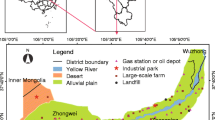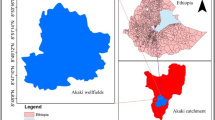Abstract
Groundwater is a globally important, valuable resource for human life and economic development. Despite its importance, it is often misused and rarely well managed. Delineation of polluted zone attains significance especially when the pollution affects the human health. Delineation can be done by many approaches: process based, statistical and overlay and index methods. Overlay and index methods are relatively simpler and are based on hydrogeological settings and other factors which are considered to control the groundwater quality in a region. Groundwater vulnerability to contamination due to anthropogenic as well as seawater intrusion in an unconfined aquifer spread over the watershed areas of Kazhakkoottam, Kulathoor and Menamkulam regions of Thiruvananthapuram District, Kerala, India, was carried out using both susceptibility index (SI) method and modified GALDIT index method. Majority of the region selected was categorised as moderately vulnerable by both indices. The cause of groundwater vulnerability to contamination was found using factor analysis. The factor score map of the study area also shows that majority of the study area is moderately affected by contamination. Hence, the area requires continuous monitoring of groundwater quality to prevent the contamination of groundwater resources for future generations.


















Similar content being viewed by others
References
Ayed, B., Jmal, I., Sahal, S., & Bouri, S. (2017). Assessment of groundwater vulnerability using a specific vulnerability method: case of Maritime Djeffara shallow aquifer (Southeastern Tunisia). Arabian Journal of Geosciences, 6(10), 30–35.
Brindha, K., & Elango, L. (2015). Cross comparison of five popular groundwater pollution vulnerability index approaches. Journal of Hydrology, 524, 597–613.
Chachadi, A. G. (2005). Seawater intrusion mapping using modified GALDIT indicator model - case study in Goa. Jalavigyan Sameeksha, 20, 29–45.
Chachadi, A.G., Lobo Ferreira, J. P. C., Noronha, L., Choudri, B. S. (2003). Assessing the impact of sea-level rise on salt water intrusion in coastal aquifers using GALDIT model, APRH/CEAS, Seminário Sobre Águas Subterrâneas, Lisboa, Fev., pp. 1-14
Honnanagoudar, S. S., Reddy, D. V., & Mahesha, A. (2014). Analysis of vulnerability assessment in the coastal Dakshina Kannada District, Mulki to Talapady Area, Karnataka. International Journal of Computational Engineering Research (IJCER), 4(5), 19–24.
Hynds, P., Misstear, B. D., Gill, L. W., & Murphy, H. M. (2014). Groundwater source contamination mechanisms: physicochemical profile clustering, risk factor analysis and multivariate modelling. Journal of Contaminant Hydrology, 2(1), 1–24.
Indian Standards Drinking Water Specifications, IS 10500 (2012). Bureau of Indian Standards, Manak Bhavan, Bahadur Shah.
Karuna P., Sindhu G. (2014). “Vulnerability assessment of coastal aquifer to sea water intrusion”, Department of Hydraulics, Civil Engg. Dept., Mtech Thesis Report.
Klassen J., Allen D.M., Kirste D. (2014). “Chemical indicators of saltwater intrusion for the Gulf Islands, British Columbia”, Department of Earth Sciences, Thesis report.
Li, P., Qian, H., Wu, J., Zhang, Y., & Zhang, H. (2013). Major ion chemistry of shallow groundwater in the Dongsheng coalfield, Ordos Basin, China. Mine Water and the Environment, 32(3), 195–206. https://doi.org/10.1007/s10230-013-0234-8.
Qian, H., Li, P., Howard, K.W.F., Yang, C., Zhang, X. (2012). Assessment of groundwater vulnerability in the Yinchuan Plain, Northwest China using OREADIC. Environmental Monitoring and Assessment, 184(6), 3613–3628. doi:https://doi.org/10.1007/s10661-011-2211-7.
Research Unit Local Self Government (RULSG), Centre for Development Studies, Thiruvananthapuram. (2017). Report on river restoration in Kerala: developing a co-evolutionary framework and river restoration action plan for Thiruvananthapuram City, Thiruvananthapuram.
Saaty, T. L. (2008). Decision making with analytic hierarchy process. International Journal of Services Sciences, 1(1), 83–98.
Subramanya K. (2008) Engineering hydrology, McGraw Hill, Third edition.
Zotarelli L., Dukes M.D., Romero C.C., Migliaccio K.W., and Morgan K.T., (2010), Step by step calculation of the Penman-Monteith evapotranspiration (FAO-56 method), U.S. Department of Agriculture, UF/IFAS, 3(5), pp. 5–15.
Acknowledgments
We owe our gratitude to the Director, Indian Meteorological Department (IMD), Thiruvananthapuram, for providing with all the required meteorological data of the study area.
Author information
Authors and Affiliations
Corresponding author
Additional information
Publisher’s note
Springer Nature remains neutral with regard to jurisdictional claims in published maps and institutional affiliations.
Rights and permissions
About this article
Cite this article
R., R., G., S. Assessment of groundwater vulnerability to contamination: a case study. Environ Monit Assess 191, 356 (2019). https://doi.org/10.1007/s10661-019-7493-1
Received:
Accepted:
Published:
DOI: https://doi.org/10.1007/s10661-019-7493-1




